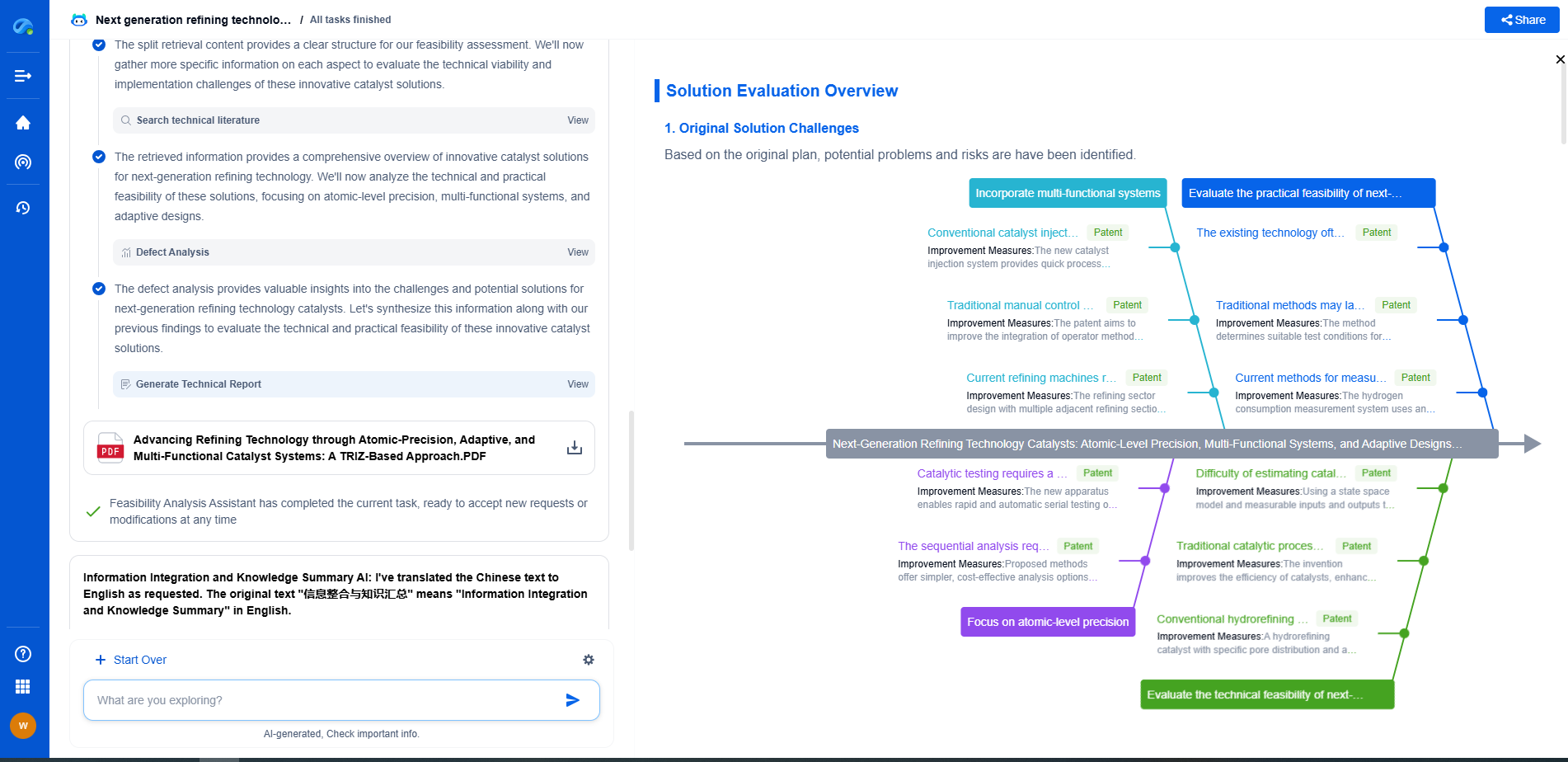Liquid vs Solid Electrolyte: Pros and Cons Compared
JUN 20, 2025 |
The development of batteries has significantly advanced in recent years, driven by the demand for safer, more efficient, and environmentally friendly energy storage solutions. A critical component of any battery is the electrolyte, which serves as a medium for ion transfer between the anode and cathode. Currently, two main types of electrolytes are widely used in battery technology: liquid electrolytes and solid electrolytes. Each type has its own distinct advantages and disadvantages. In this blog, we will delve into the pros and cons of liquid and solid electrolytes to understand their roles in shaping the future of battery technology.
Understanding Liquid Electrolytes
Liquid electrolytes are commonly used in traditional lithium-ion batteries. They are typically composed of a lithium salt dissolved in an organic solvent, allowing for high ionic conductivity. This type of electrolyte is well established in the market and is widely used in consumer electronics, electric vehicles, and renewable energy storage systems.
Advantages of Liquid Electrolytes
1. High Ionic Conductivity: One of the main advantages of liquid electrolytes is their excellent ionic conductivity. This property facilitates rapid ion transfer, essential for achieving high power outputs and fast charging.
2. Established Manufacturing Processes: The production of liquid electrolytes is well understood, and the processes are highly optimized. This results in reduced production costs and easier integration into existing battery production lines.
3. Flexibility: Liquid electrolytes can accommodate volume changes in the battery during charge and discharge cycles, which reduces mechanical stress on the battery components and prolongs battery life.
Disadvantages of Liquid Electrolytes
1. Safety Concerns: Liquid electrolytes are flammable and pose a risk of leakage, which can lead to fires and explosions, especially under stress or high temperatures.
2. Limited Temperature Range: The performance of liquid electrolytes decreases significantly at extreme temperatures, impacting the efficiency and reliability of batteries in diverse environments.
3. Environmental Impact: The organic solvents used in liquid electrolytes can be harmful to the environment, posing challenges in terms of disposal and recycling.
Exploring Solid Electrolytes
Solid electrolytes are an emerging technology with the potential to overcome many of the limitations of liquid electrolytes. These are made from inorganic materials, often ceramics or glass, and are being explored for use in next-generation batteries, such as solid-state batteries.
Advantages of Solid Electrolytes
1. Enhanced Safety: Solid electrolytes are non-flammable and reduce the risk of leakage, making them significantly safer than their liquid counterparts. This property is particularly beneficial for applications in electric vehicles and large-scale energy storage.
2. Wider Temperature Range: Solid electrolytes can operate efficiently across a broader temperature range, maintaining performance in both extreme cold and heat.
3. Improved Energy Density: Solid-state batteries, which use solid electrolytes, can potentially offer higher energy densities, translating into longer battery life and greater range for electronic devices and electric vehicles.
Disadvantages of Solid Electrolytes
1. Lower Ionic Conductivity: Solid electrolytes generally have lower ionic conductivity compared to liquid electrolytes, which can affect the battery's power output and charging speed.
2. Complex Manufacturing: The production of solid electrolytes involves complex processes that can be costly and challenging to scale up for mass production.
3. Interfacial Challenges: Solid electrolytes can suffer from interfacial resistance issues where they contact the electrodes, which can hinder performance and durability.
Conclusion
In the ongoing quest to develop better batteries, both liquid and solid electrolytes present unique advantages and challenges. Liquid electrolytes, with their high ionic conductivity and established production processes, continue to be the backbone of current battery technology. However, safety and environmental concerns drive the exploration of solid electrolytes, which offer promising improvements in safety, temperature resilience, and energy density.
The future of battery technology likely involves a blend of these electrolytes or the development of new materials that combine the best of both worlds. As research and innovation continue, we can anticipate more advanced and sustainable battery solutions emerging, which will have a profound impact on the way we store and manage energy across various applications.
Accelerate Breakthroughs in Fuel Cell and Battery Innovation—with the Power of AI
From solid-state battery breakthroughs to high-efficiency hydrogen fuel cells, keeping pace with fast-evolving chemistries, global patent landscapes, and emerging application pathways is an ever-growing challenge for R&D and IP professionals.
Patsnap Eureka, our intelligent AI assistant built for R&D professionals in high-tech sectors, empowers you with real-time expert-level analysis, technology roadmap exploration, and strategic mapping of core patents—all within a seamless, user-friendly interface.
Whether you're optimizing cathode formulations, evaluating electrolyte stability, or navigating the crowded patent space around battery pack design, Eureka empowers you to move faster and with greater confidence.
Start your journey with Patsnap Eureka today—streamline your research, enhance decision-making, and power the future of energy with AI-driven clarity.
- R&D
- Intellectual Property
- Life Sciences
- Materials
- Tech Scout
- Unparalleled Data Quality
- Higher Quality Content
- 60% Fewer Hallucinations
Browse by: Latest US Patents, China's latest patents, Technical Efficacy Thesaurus, Application Domain, Technology Topic, Popular Technical Reports.
© 2025 PatSnap. All rights reserved.Legal|Privacy policy|Modern Slavery Act Transparency Statement|Sitemap|About US| Contact US: help@patsnap.com

